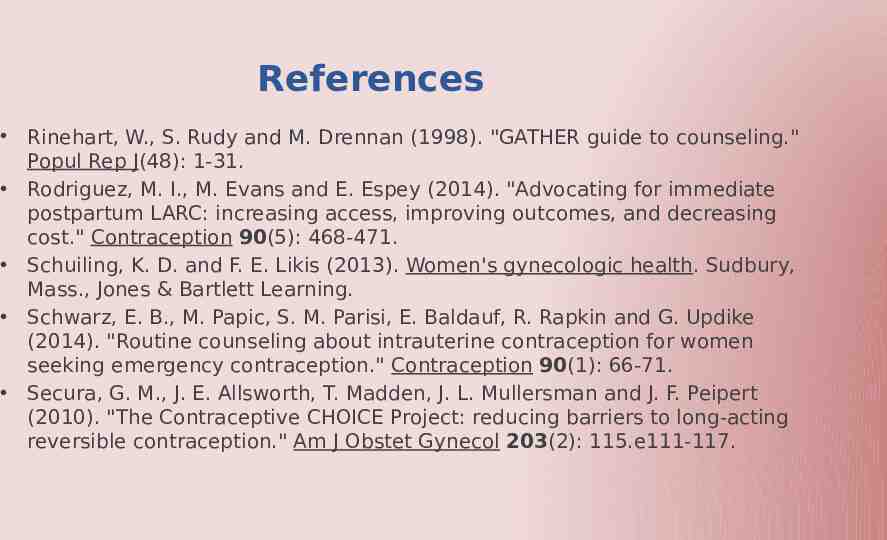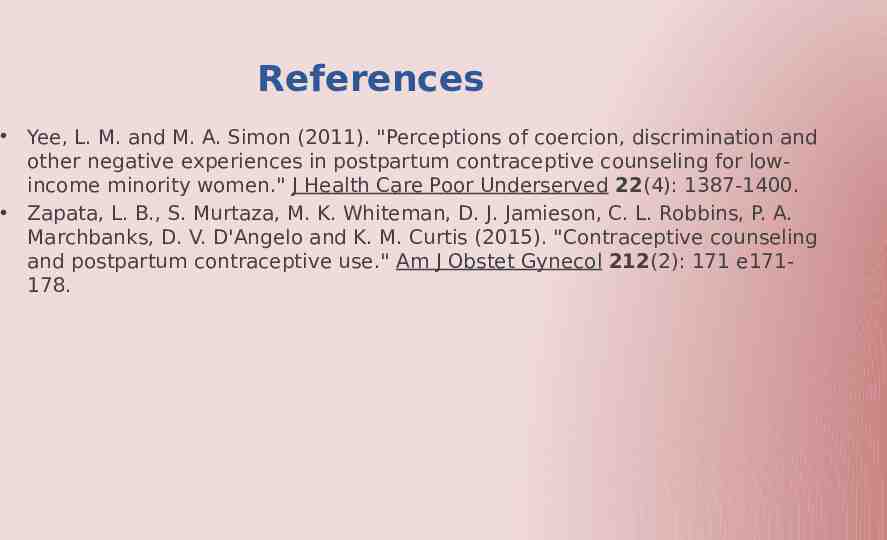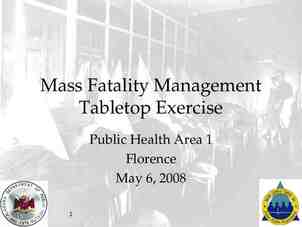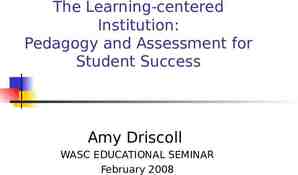Patient-Centered Reproductive Goals and Contraception
97 Slides6.69 MB

Patient-Centered Reproductive Goals and Contraception Counseling; Shared Decision-Making in Action Patty Cason MS, FNP-BC UCLA School of Nursing Envision Sexual and Reproductive Health

Disclosures Advisory Board/Consultant Teva, Medicines 360, Allergan, Merck, Bayer, ContraMed, Evofem, Trainer/speaker Merck, Medicines360, Teva, ContraMed

Objectives Demonstrate patient-centered language in patient education Describe use of appropriate questions when giving patient information. Identify questions that foster patient-centered contraceptive care

U.S. Medical Eligibility for Contraceptive Use U.S. Selected Practice Recommendations Providing Quality Family Planning Services

US Medical Eligibility Criteria: Categories 2 No restriction for the use of the contraceptive method for a woman with that condition Advantages of using the method generally outweigh the theoretical or proven risks 3 Theoretical or proven risks of the method usually outweigh the advantages – not usually recommended unless more appropriate methods are not available or acceptable 4 Unacceptable health risk if the contraceptive method is used by a woman with that condition 1 https://www.cdc.gov/mmwr/volumes/65/rr/pdfs/rr6503.pdf

U.S. Selected Practice Recommendations Provides recommendations on optimal use of contraceptive methods for persons of all ages, including adolescents.

Population level

Population-Level Goals Public health considerations Cost: benefit ratios Costs, risks, benefits to society or government Epidemiology

Individual level

Individual-Level Goals Impact on a particular person Non-contraceptive benefits of a method Consequences of pregnancy Side effects or complications from a method

Satisfaction Mirrors Continuation 75-90% of users satisfied with LARC All populations studied report high levels of satisfaction Adolescents, Adults All demographics All SES Diedrich, J. T. (2015). Am J Obstet Gynecol Rosenstock, J. R. (2012). Obstetrics and Gynecology Peipert, J. F. (2011). Obstet Gynecol Kavanaugh ML. (2013) J Pediatr Adolesc Gynecol

LARC Policy Insure full access: No cost for placement or removal All methods/no restrictions by length of use Same day placement (operationalized) Copper IUD as EC Competent counseling (with reimbursement)

Patient Education Access to: Information about the full range of methods Accessible, medically correct information Culturally appropriate information Comparative effectiveness data in understandable terms

Training Providers trained in placement and removal Primary, pediatrics, family Providers/staff trained in client-centered counseling Providers/staff trained in responding to objections and managing complications

Language for LARC “This method is good for up to years but if you want to get pregnant before then or you would like it removed for any reason, come in, we will remove it and your ability to get pregnant will return to whatever is normal for you immediately.”

Ask more questions & Talk less

Patient-centered care “Patient-centered care is care that is respectful of and responsive to individual patient preferences, needs, and values.” - Institute of Medicine Recognized by IOM as a dimension of quality Associated with improved outcomes

Shared Decision-Making “Clinicians provide patients with information about options and help them to identify their preferences in the context of their values.” Fried (2016) N Engl J Med

Shared Decision-Making in Family Planning Consistent with patient’s desires for family planning counseling Focus on patient’s preferences Provision of decision support, without pressure Associated with improved satisfaction with counseling and with choice of method Dehlendorf C, (2013) Contraception

Efficient Patient-Centered Questions

Reproductive Intention/Goals PATH Questions 1.Do you think you would like to have (more) children some day? 2.When do you think that might be? 3.How important is it to you to prevent pregnancy (until then)?

Reproductive Goals Clarifies motivation and degree of acceptability regarding pregnancy so we discuss appropriate interventions /Contraception /Preconception Care Basic Infertility Services

Preconception Care “Since would you like to discuss ways to be prepared for a healthy pregnancy?” For example you have said “if it happens, it happens” many women using this method of contraception get pregnant

Best Question When the Answer is “No time soon ” Not, “What method are you interested in?”

Characteristics of Contraceptive Methods Do you have a sense of what is important to you about your method? Do you have a sense of what you are looking for in a contraceptive method? Dehlendorf C, (2016)

Attitude about Effectiveness Hormones Menstrual cycle and bleeding profile Length of use Control over removal Object in her body Return to fertility Non-contraceptive benefits Side effects

Counseling Skills

Re-phrasing “So I hear you saying (you really like the idea of using a method without hormones) do I have that right?” “It sounds like.(It’s very important to you not to get pregnant until you are out of school and you would love a method that you don’t have to think about) does that sound right?”

Alternate “Many of my patients say (that they worry about gaining weight with contraception) is that what you mean?”

Establish Rapport, Show Empathy

Positive Feedback (THEIR Values) Condom use, adherence to a method, exercise, quit smoking, or a good question You are both on the same side -theirs! Builds trust Encourages them coming from their “best self”

Positive Feedback “It’s great that you were so strong in standing up for yourself (asking your partner to use condoms.)” “You’ve clearly thought about this a lot so what do you make of this situation?” “Not many people (your age) act so responsibly about using a condom every time.”

Empathy Without Labeling Rather than: “You sound angry” (or anxious) Not: “I know how you feel.” Use neutral words: “It sounds like is concerning to you” “Anyone would find hard to deal with”

Try NOT to Disagree “Find the yes” Find something in what they are saying to agree with .and then add your scientific or medical information. “Yes! . and ” Instead of “No” or “But”

Find the “Yes” Rather than: “No, that’s not true! Don’t trust “Dr. Google” Try: “I can see you like to inform yourself!” “I have a great resource for you that I think you will love ” (Bedsider)

Addressing Patient’s Concerns “That’s too bad your friend had that experience. I haven’t heard of that before, and I can tell you it definitely doesn’t happen frequently.” Christine Dehlendorf 2016

Health Literacy

“The degree to which individuals have the capacity to obtain, process, and understand basic health information and services needed to make appropriate health decisions.” Healthy People 2010

How does it feel reading this? If you have any of the fjposu symptoms, call the loskslh immediately: Aslfhip pain Sudden lknsoe Any lasj in your lskneo

Consequences---Clues Frequently missed appointments Lack of follow through with tests or referrals Adherence issues Unable to name medications, purpose or dose Ask fewer questions

Provide Quality Patient Education

Mismatched Communication

Limit the Amount of Information Humans do not integrate much of the information provided More information less retention Focus on specific needs and knowledge gaps

Information Sandwich Sandwich the one piece of information you want to give between questions Following information with a question requires the patient to interact with the information Understand remember integrate

A small amount of information Information Sandwich With questions on each side

Questions How would that be for you? Knowing that, how would it be for you ? Has it ever happened before? How did you manage it? Do you have a sense of how you would manage it?

Q: “How would it be for you if you didn’t get your period while you are using the implant?” A: “That would not be good” Q: “What is it about not getting your period that concerns you?” A: “My mom said it’s not healthy not to get my period”

The YES: “Your mother is completely right, when you are not on contraceptive hormones it is important to get you period every month, it’s great that you know that. The Science: Interestingly, if a woman is using contraceptive hormones it keeps her uterus very healthy and thin. It actually prevents cancer of the uterus” Question: “Knowing that, how would it be for you not getting periods?”

Visual and Tactile Aids Demonstrate/draw pictures Clearly written education materials Illustrations 3-D models

Demo Unit IUDs and Implant Give them the unit to hold, feel and play with while discussing the method how to feel the threads what the plastic feels like if it is expelling

Second Tier Combined Hormonal Contraceptives

Language for Patient Education

Examples of Plain Language Annually Topically Eligible Fertility Hypertension Dermatologist Yearly or every year On the skin Able to get Ability to get pregnant High blood pressure Skin doctor The Plain Language Thesaurus for Health Communications http://depts.washington.edu/respcare/public/info/Plain Language Thesaurus for Health Communications.pdf

Misconceptions All contraception is equally effective Underestimate their fertility Pregnancy confirms fertility No need for effective contraception Pregnancy is safer than contraception

Use Natural Frequencies And Common Denominators “If a woman switches from the pill to an IUD her chance of unintended pregnancy is reduced from 9 in 100 to 1 in 100”

Teach Back “I’ve just gone over a ton of information and I’m not always as clear as I would like to be or “Just to be sure I didn’t forget to tell you something Do you understand? AND Do you have any questions? “What questions do you have?”

Obstacles

On one hand Goal Behavior On the other hand

Find the Obstacle Goal Obstacle

Ask more questions & Talk less

Thank you!

Questions?

https://www.ahrq.gov/sites/default/files/wysiwyg/professionals/qualitypatient-safety/quality-resources/tools/literacy-toolkit/ healthlittoolkit2.pdf Brega AG, et al. AHRQ Health Literacy Universal Precautions Toolkit, Second Edition 2015.

References Aiken, A. R. A., S. Borrero, L. S. Callegari and C. Dehlendorf (2016). "Rethinking the Pregnancy Planning Paradigm: Unintended Conceptions or Unrepresentative Concepts?" Perspectives on Sexual and Reproductive Health 48(3): 147-151. Aiken, A. R. A., C. L. Westhoff, J. Trussell and P. M. Castaño (2016). "Comparison of a Timing‐Based Measure of Unintended Pregnancy and the London Measure of Unplanned Pregnancy." Perspectives on Sexual and Reproductive Health 48(3): 139-146. Arrowsmith, M. E., C. R. Aicken, S. Saxena and A. Majeed (2012). "Strategies for improving the acceptability and acceptance of the copper intrauterine device." Cochrane Database Syst Rev(3): Cd008896. Bailey, M. J., M. Guldi and B. J. Hershbein (2013). "Recent evidence on the broad benefits of reproductive health policy." J Policy Anal Manage 32(4): 888-896. Battaglia, C., B. Battaglia, F. Mancini, P. Busacchi, M. C. Paganotto, E. Morotti and S. Venturoli (2012). "Sexual behavior and oral contraception: a pilot study." J Sex Med 9(2): 550-557.

References Baydar, N. (1995). "Consequences for children of their birth planning status." Fam Plann Perspect 27(6): 228-234, 245. Becker, D., M. A. Koenig, Y. M. Kim, K. Cardona and F. L. Sonenstein (2007). "The quality of family planning services in the United States: findings from a literature review." Perspect Sex Reprod Health 39(4): 206-215. Becker, D. and A. O. Tsui (2008). "Reproductive health service preferences and perceptions of quality among low-income women: racial, ethnic and language group differences." Perspect Sex Reprod Health 40(4): 202-211. Benson, L. S., A. Perrucci, E. A. Drey and J. E. Steinauer (2012). "Effect of shared contraceptive experiences on IUD use at an urban abortion clinic." Contraception 85(2): 198-203. Biggs, M. A., D. Karasek and D. G. Foster (2012). "Unprotected intercourse among women wanting to avoid pregnancy: attitudes, behaviors, and beliefs." Womens Health Issues 22(3): e311-318. Borrero, S., C. Nikolajski, J. R. Steinberg, L. Freedman, A. Y. Akers, S. Ibrahim and E. B. Schwarz (2015). ""It just happens": a qualitative study exploring low-income women's perspectives on pregnancy intention and planning." Contraception 91(2): 150-156.

References Borrero, S., E. B. Schwarz, M. Creinin and S. Ibrahim (2009). "The impact of race and ethnicity on receipt of family planning services in the United States." J Womens Health (Larchmt) 18(1): 91-96. Boston Women's Health Book Collective. (2011). Our bodies, ourselves. New York, Simon & Schuster. Burns, B., K. Grindlay and A. Dennis (2015). "Women's Awareness of, Interest in, and Experiences with Long-acting Reversible and Permanent Contraception." Womens Health Issues 25(3): 224-231. Callegari, L. S., A. R. Aiken, C. Dehlendorf, P. Cason and S. Borrero (2017). "Addressing potential pitfalls of reproductive life planning with patient-centered counseling." Am J Obstet Gynecol 216(2): 129-134. Carvajal, D. N., D. Gioia, E. R. Mudafort, P. B. Brown and B. Barnet (2017). "How can Primary Care Physicians Best Support Contraceptive Decision Making? A Qualitative Study Exploring the Perspectives of Baltimore Latinas." Women's Health Issues 27(2): 158-166.

References Cates, W., Jr., J. Stanback and B. Maggwa (2014). "Global family planning metrics - time for new definitions?" Contraception 90(5): 472-475. Chen, X. K., S. W. Wen, N. Fleming, K. Demissie, G. G. Rhoads and M. Walker (2007). "Teenage pregnancy and adverse birth outcomes: a large population based retrospective cohort study." Int J Epidemiol 36(2): 368-373. Cheng, D., E. B. Schwarz, E. Douglas and I. Horon (2009). "Unintended pregnancy and associated maternal preconception, prenatal and postpartum behaviors." Contraception 79(3): 194-198. Craig, A. D., C. Dehlendorf, S. Borrero, C. C. Harper and C. H. Rocca (2014). "Exploring young adults' contraceptive knowledge and attitudes: disparities by race/ethnicity and age." Womens Health Issues 24(3): e281-289. Davidson, A. R. and D. Kalmuss (1997). "Topics for our times: Norplant coercion--an overstated threat." Am J Public Health 87(4): 550-551.

References Dehlendorf, C., H. Bellanca and M. Policar (2015). "Performance measures for contraceptive care: what are we actually trying to measure?" Contraception 91(6): 433437. Dehlendorf, C., A. S. Bryant, H. G. Huddleston, V. L. Jacoby and V. Y. Fujimoto (2010). "Health disparities: definitions and measurements." Am J Obstet Gynecol 202(3): 212213. Dehlendorf, C., J. Diedrich, E. Drey, A. Postone and J. Steinauer (2010). "Preferences for decision-making about contraception and general health care among reproductive age women at an abortion clinic." Patient Educ Couns 81(3): 343-348. Dehlendorf, C., J. Fitzpatrick, J. Steinauer, L. Swiader, K. Grumbach, C. Hall and M. Kuppermann (2017). "Development and field testing of a decision support tool to facilitate shared decision making in contraceptive counseling." Patient Educ Couns. Dehlendorf, C., L. Gavin and S. Moskosky (2016). "Providing family planning care in the context of Zika: a toolkit for providers from the US Office of Population Affairs." Contraception.

References Dehlendorf, C., K. Grumbach, E. Vittinghoff, R. Ruskin and J. Steinauer (2011). "A study of physician recommendations for reversible contraceptive methods using standardized patients." Perspect Sex Reprod Health 43(4): 224-229. Dehlendorf, C., J. T. Henderson, E. Vittinghoff, K. Grumbach, K. Levy, J. Schmittdiel, J. Lee, D. Schillinger and J. Steinauer (2016). "Association of the quality of interpersonal care during family planning counseling with contraceptive use." Am J Obstet Gynecol 215(1): 78.e71-79. Dehlendorf, C., K. Kimport, K. Levy and J. Steinauer (2014). "A qualitative analysis of approaches to contraceptive counseling." Perspect Sex Reprod Health 46(4): 233-240. Dehlendorf, C., C. Krajewski and S. Borrero (2014). "Contraceptive counseling: best practices to ensure quality communication and enable effective contraceptive use." Clin Obstet Gynecol 57(4): 659-673. Dehlendorf, C., K. Levy, A. Kelley, K. Grumbach and J. Steinauer (2013). "Women's preferences for contraceptive counseling and decision making." Contraception 88(2): 250-256.

References Dehlendorf, C., S. Y. Park, C. A. Emeremni, D. Comer, K. Vincett and S. Borrero (2014). "Racial/ethnic disparities in contraceptive use: variation by age and women's reproductive experiences." Am J Obstet Gynecol 210(6): 526 e521529. Dehlendorf, C. and W. Rinehart (2010). "Communication in reproductive health: intimate topics and challenging conversations." Patient Educ Couns 81(3): 321323. Dehlendorf, C., M. I. Rodriguez, K. Levy, S. Borrero and J. Steinauer (2010). "Disparities in family planning." Am J Obstet Gynecol 202(3): 214-220. Dehlendorf, C., R. Ruskin, K. Grumbach, E. Vittinghoff, K. Bibbins-Domingo, D. Schillinger and J. Steinauer (2010). "Recommendations for intrauterine contraception: a randomized trial of the effects of patients' race/ethnicity and socioeconomic status." Am J Obstet Gynecol 203(4): 319 e311-318.

References Dehlendorf, C., M. Tharayil, N. Anderson, K. Gbenedio, A. Wittman and J. Steinauer (2014). "Counseling about IUDs: a mixed-methods analysis." Perspect Sex Reprod Health 46(3): 133-140. Diedrich, J. T., T. Madden, Q. Zhao and J. F. Peipert (2015). "Long-term utilization and continuation of intrauterine devices." Am J Obstet Gynecol. Downey, M. M., S. Arteaga, E. Villaseñor and A. M. Gomez "More Than a Destination: Contraceptive Decision Making as a Journey." Women's Health Issues. Downing, R. A., T. A. LaVeist and H. E. Bullock (2007). "Intersections of ethnicity and social class in provider advice regarding reproductive health." Am J Public Health 97(10): 1803-1807. Doyle, C., L. Lennox and D. Bell (2013). "A systematic review of evidence on the links between patient experience and clinical safety and effectiveness." BMJ Open 3(1).

References ED., S. J. B. (2014). " Applying Principles from Behavioral Economics To Promote LongActing Reversible Contraceptive (LARC) Methods.pdf ." Perspect Sex Reprod Health 46(3): 165-170. Eisenberg, D., C. McNicholas and J. F. Peipert (2013). "Cost as a barrier to long-acting reversible contraceptive (LARC) use in adolescents." J Adolesc Health 52(4 Suppl): S5963. Eisenberg, D. L., G. M. Secura, T. E. Madden, J. E. Allsworth, Q. Zhao and J. F. Peipert (2012). "Knowledge of contraceptive effectiveness." Am J Obstet Gynecol 206(6): 479 e471-479. Finer, L. B., J. Jerman and M. L. Kavanaugh (2012). "Changes in use of long-acting contraceptive methods in the United States, 2007-2009." Fertil Steril 98(4): 893-897. Finer, L. B. and M. R. Zolna (2014). "Shifts in intended and unintended pregnancies in the United States, 2001-2008." Am J Public Health 104 Suppl 1: S43-48. Finer, L. B. and M. R. Zolna (2016). "Declines in Unintended Pregnancy in the United States, 2008-2011." N Engl J Med 374(9): 843-852.

References Fleming, K. L., A. Sokoloff and T. R. Raine (2010). "Attitudes and beliefs about the intrauterine device among teenagers and young women." Contraception 82(2): 178-182. Forrest, J. D. and R. Samara (1996). "Impact of publicly funded contraceptive services on unintended pregnancies and implications for Medicaid expenditures." Fam Plann Perspect 28(5): 188-195. Foster, D. G., M. A. Biggs, J. Malvin, M. Bradsberry, P. Darney and C. D. Brindis (2013). "Cost-savings from the provision of specific contraceptive methods in 2009." Womens Health Issues 23(4): e265-271. Foster, D. G., D. Grossman, D. K. Turok, J. F. Peipert, L. Prine, C. A. Schreiber, A. V. Jackson, R. E. Barar and E. B. Schwarz (2014). "Interest in and experience with IUD self-removal." Contraception 90(1): 54-59. Fried, T. R. (2016). "Shared Decision Making--Finding the Sweet Spot." N Engl J Med 374(2): 104-106.

References Garbers, S., A. Meserve, M. Kottke, R. Hatcher and M. A. Chiasson (2012). "Tailored health messaging improves contraceptive continuation and adherence: results from a randomized controlled trial." Contraception 86(5): 536-542. Geronimus, A. T. (2003). "Damned if you do: culture, identity, privilege, and teenage childbearing in the United States." Soc Sci Med 57(5): 881-893. Geronimus, A. T. (2004). "Teenage childbearing as cultural prism." Br Med Bull 69: 155-166. Geronimus, A. T. (2013). "Deep integration: letting the epigenome out of the bottle without losing sight of the structural origins of population health." Am J Public Health 103 Suppl 1: S56-63. Geronimus, A. T., M. Hicken, D. Keene and J. Bound (2006). ""Weathering" and age patterns of allostatic load scores among blacks and whites in the United States." Am J Public Health 96(5): 826-833.

References Geronimus, A. T., M. T. Hicken, J. A. Pearson, S. J. Seashols, K. L. Brown and T. D. Cruz (2010). "Do US Black Women Experience Stress-Related Accelerated Biological Aging?: A Novel Theory and First Population-Based Test of BlackWhite Differences in Telomere Length." Hum Nat 21(1): 19-38. Gilliam, M. L. (2015). "Beyond Coercion: Let Us Grapple With Bias." Obstet Gynecol. Gipson, J. D., M. A. Koenig and M. J. Hindin (2008). "The effects of unintended pregnancy on infant, child, and parental health: a review of the literature." Stud Fam Plann 39(1): 18-38. Goldthwaite, L. M., L. Duca, R. K. Johnson, D. Ostendorf and J. Sheeder (2015). "Adverse Birth Outcomes in Colorado: Assessing the Impact of a Statewide Initiative to Prevent Unintended Pregnancy." Am J Public Health 105(9): e60-66.

References Grady, C. D., C. Dehlendorf, E. D. Cohen, E. B. Schwarz and S. Borrero (2015). "Racial and ethnic differences in contraceptive use among women who desire no future children, 2006-2010 National Survey of Family Growth." Contraception 92(1): 62-70. Gubrium, A. C., E. S. Mann, S. Borrero, C. Dehlendorf, J. Fields, A. T. Geronimus, A. M. Gomez, L. H. Harris, J. A. Higgins, K. Kimport, K. Luker, Z. Luna, L. Mamo, D. Roberts, D. Romero and G. Sisson (2016). "Realizing Reproductive Health Equity Needs More Than Long-Acting Reversible Contraception (LARC)." Am J Public Health 106(1): 1819. Hall, K. S., J. R. Steinberg, C. A. Cwiak, R. H. Allen and S. M. Marcus (2015). "Contraception and mental health: a commentary on the evidence and principles for practice." Am J Obstet Gynecol 212(6): 740-746. Han, L., S. B. Teal, J. Sheeder and K. Tocce (2014). "Preventing repeat pregnancy in adolescents: is immediate postpartum insertion of the contraceptive implant cost effective?" Am J Obstet Gynecol 211(1): 24 e21-27.

References Harper, C. C., C. H. Rocca, K. M. Thompson, J. Morfesis, S. Goodman, P. D. Darney, C. L. Westhoff and J. J. Speidel (2015). "Reductions in pregnancy rates in the USA with long-acting reversible contraception: a cluster randomised trial." The Lancet 386(9993): 562-568. Harris, L. H. and T. Wolfe (2014). "Stratified reproduction, family planning care and the double edge of history." Curr Opin Obstet Gynecol 26(6): 539-544. Henning, P. A., C. K. Burgess, H. E. Jones and W. V. Norman (2017). "The effects of asking a fertility intention question in primary care settings: a systematic review protocol." Syst Rev 6(1): 11. Higgins, J. A. (2014). "Celebration meets caution: LARC's boons, potential busts, and the benefits of a reproductive justice approach." Contraception 89(4): 237-241. Insogna, I. and A. Fiester (2015). "Sterilization as last resort in women with intellectual disabilities: protection or disservice?" Am J Obstet Gynecol 212(1): 34-36.e31. Jackson, A. V., D. Karasek, C. Dehlendorf and D. G. Foster (2016). "Racial and ethnic differences in women's preferences for features of contraceptive methods." Contraception 93(5): 406-411.

References Kalmuss, D., A. Davidson, L. Cushman, S. Heartwell and M. Rulin (1998). "Potential barriers to the removal of Norplant among family planning clinic patients." Am J Public Health 88(12): 1846-1849. Kavanaugh, M. L., J. Jerman and L. B. Finer (2015). "Changes in Use of LongActing Reversible Contraceptive Methods Among U.S. Women, 2009-2012." Obstet Gynecol. Kennedy, S., M. Grewal, E. M. Roberts, J. Steinauer and C. Dehlendorf (2014). "A qualitative study of pregnancy intention and the use of contraception among homeless women with children." J Health Care Poor Underserved 25(2): 757-770. Kols, A. J., J. E. Sherman and P. T. Piotrow (1999). "Ethical foundations of clientcentered care in family planning." J Womens Health 8(3): 303-312. Kost, K., D. J. Landry and J. E. Darroch (1998). "The effects of pregnancy planning status on birth outcomes and infant care." Fam Plann Perspect 30(5): 223-230.

References Langston, A. M., L. Rosario and C. L. Westhoff (2010). "Structured contraceptive counseling--a randomized controlled trial." Patient Educ Couns 81(3): 362-367. Levy, K., A. M. Minnis, M. Lahiff, J. Schmittdiel and C. Dehlendorf (2015). "Bringing patients' social context into the examination room: an investigation of the discussion of social influence during contraceptive counseling." Womens Health Issues 25(1): 13-21. Lessard, L. N., Karasek, D., Ma, S., Darney, P., Deardorff, J., Lahiff, M., . . . Foster, D. G. (2012). Contraceptive features preferred by women at high risk of unintended pregnancy. Perspect Sex Reprod Health, 44(3), 194-200. Lopez, L. M., T. W. Grey, M. Chen, E. E. Tolley and L. L. Stockton (2016). "Theory-based interventions for contraception." Cochrane Database Syst Rev 11: Cd007249. Lopez, L. M., M. Steiner, D. A. Grimes, D. Hilgenberg and K. F. Schulz (2013). "Strategies for communicating contraceptive effectiveness." Cochrane Database Syst Rev(4): Cd006964. Luchowski, A. T., B. L. Anderson, M. L. Power, G. B. Raglan, E. Espey and J. Schulkin (2014). "Obstetrician-gynecologists and contraception: long-acting reversible contraception practices and education." Contraception 89(6): 578-583.

References Luchowski, A. T., B. L. Anderson, M. L. Power, G. B. Raglan, E. Espey and J. Schulkin (2014). "Obstetrician-gynecologists and contraception: practice and opinions about the use of IUDs in nulliparous women, adolescents and other patient populations." Contraception 89(6): 572-577. Madden, T., J. L. Mullersman, K. J. Omvig, G. M. Secura and J. F. Peipert (2013). "Structured contraceptive counseling provided by the Contraceptive CHOICE Project." Contraception 88(2): 243-249. Major, I., P. Boyd, M. Kilbourne-Brook, G. Saxon, J. Cohen and R. K. Malcolm (2013). "A modified SILCS contraceptive diaphragm for long-term controlled release of the HIV microbicide dapivirine." Contraception 88(1): 58-66. Malat, J. (2000). "Racial differences in Norplant use in the United States." Soc Sci Med 50(9): 1297-1308. Marshall, C., S. Guendelman, J. Mauldon and A. Nuru-Jeter (2016). "Young Women's Contraceptive Decision Making: Do Preferences for Contraceptive Attributes Align with Method Choice?" Perspect Sex Reprod Health 48(3): 119-127.
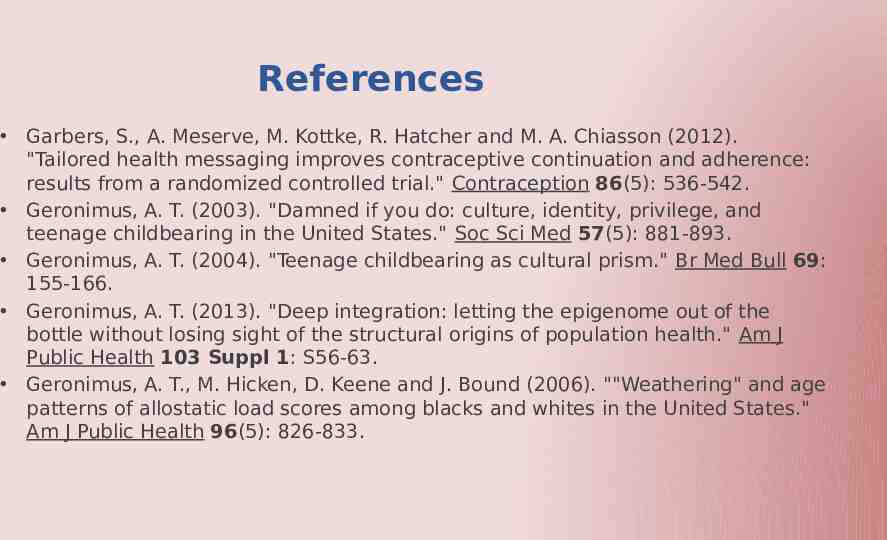
References McLean, M., J. Steinauer, J. Schmittdiel, P. Chan and C. Dehlendorf (2016). "Provider self-disclosure during contraceptive counseling." Contraception. Meade, C. S. and J. R. Ickovics (2005). "Systematic review of sexual risk among pregnant and mothering teens in the USA: pregnancy as an opportunity for integrated prevention of STD and repeat pregnancy." Soc Sci Med 60(4): 661678. Miller, E., H. L. McCauley, D. J. Tancredi, M. R. Decker, H. Anderson and J. G. Silverman (2014). "Recent reproductive coercion and unintended pregnancy among female family planning clients." Contraception 89(2): 122-128. Moaddab, A., L. B. McCullough, F. A. Chervenak, K. A. Fox, K. M. Aagaard, B. Salmanian, S. P. Raine and A. A. Shamshirsaz (2015). "Health care justice and its implications for current policy of a mandatory waiting period for elective tubal sterilization." Am J Obstet Gynecol 212(6): 736-739.

References Modesto, W., M. V. Bahamondes and L. Bahamondes (2014). "A randomized clinical trial of the effect of intensive versus non-intensive counselling on discontinuation rates due to bleeding disturbances of three long-acting reversible contraceptives." Hum Reprod 29(7): 1393-1399. Morales-Rosello, J. (2005). "Spontaneous upward movement of lowly placed Tshaped IUDs." Contraception 72(6): 430-431. Morse, J. E., S. Ramesh and A. Jackson (2017). "Reassessing Unintended Pregnancy: Toward a Patient-centered Approach to Family Planning." Obstetrics and Gynecology Clinics of North America 44(1): 27-40. Moskosky, S. B. (2016). "Pregnancy Intention—More Important Than Ever." Public Health Reports 131(5): 658-660. Mumford, S. L., K. J. Sapra, R. B. King, J. F. Louis and G. M. Buck Louis (2016). "Pregnancy intentions—a complex construct and call for new measures." Fertility and Sterility 106(6): 1453-1462.
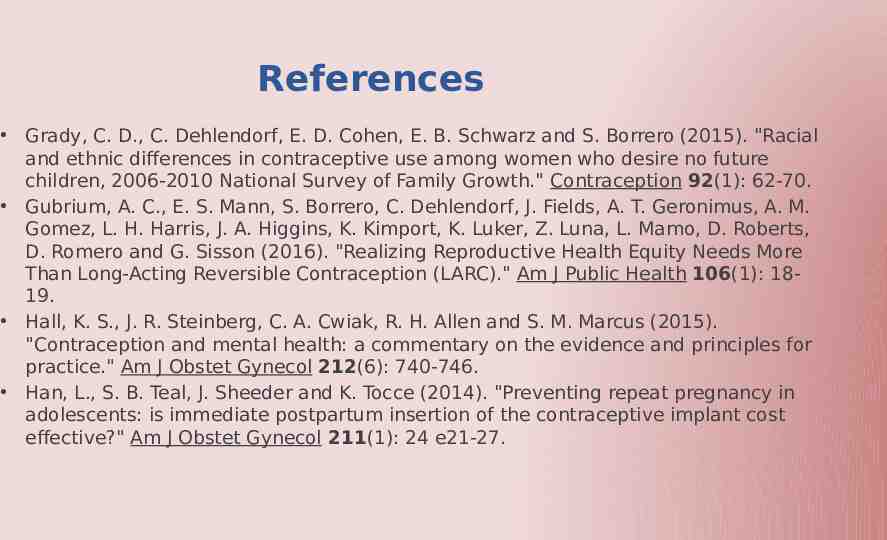
References Petersen, R., P. Payne, J. Albright, H. Holland, R. Cabral and K. M. Curtis (2004). "Applying motivational interviewing to contraceptive counseling: ESP for clinicians." Contraception 69(3): 213-217. Politi, M. C., A. Estlund, A. Milne, C. M. Buckel, J. F. Peipert and T. Madden (2016). "Barriers and facilitators to implementing a patient-centered model of contraceptive provision in community health centers." Contraception and Reproductive Medicine 1(1): 21. Potter, J. E., K. Hopkins, A. R. Aiken, C. Hubert, A. J. Stevenson, K. White and D. Grossman (2014). "Unmet demand for highly effective postpartum contraception in Texas." Contraception 90(5): 488-495. Ricketts, S., G. Klingler and R. Schwalberg (2014). "Game change in Colorado: widespread use of long-acting reversible contraceptives and rapid decline in births among young, low-income women." Perspect Sex Reprod Health 46(3): 125-132.
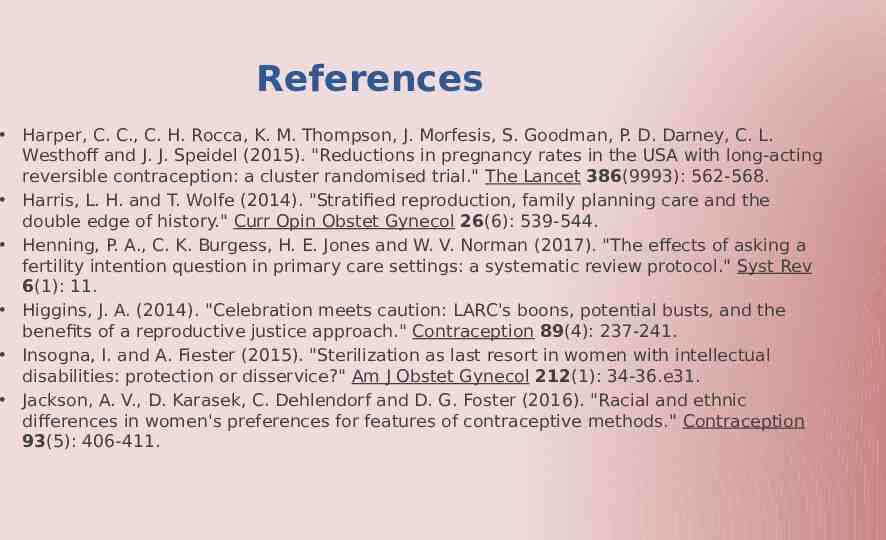
References Rinehart, W., S. Rudy and M. Drennan (1998). "GATHER guide to counseling." Popul Rep J(48): 1-31. Rodriguez, M. I., M. Evans and E. Espey (2014). "Advocating for immediate postpartum LARC: increasing access, improving outcomes, and decreasing cost." Contraception 90(5): 468-471. Schuiling, K. D. and F. E. Likis (2013). Women's gynecologic health. Sudbury, Mass., Jones & Bartlett Learning. Schwarz, E. B., M. Papic, S. M. Parisi, E. Baldauf, R. Rapkin and G. Updike (2014). "Routine counseling about intrauterine contraception for women seeking emergency contraception." Contraception 90(1): 66-71. Secura, G. M., J. E. Allsworth, T. Madden, J. L. Mullersman and J. F. Peipert (2010). "The Contraceptive CHOICE Project: reducing barriers to long-acting reversible contraception." Am J Obstet Gynecol 203(2): 115.e111-117.

References Shapiro, T. M., W. Fisher and A. Diana (1983). "Family planning and female sterilization in the United States." Soc Sci Med 17(23): 1847-1855. Shih, G., K. Dube and C. Dehlendorf (2013). ""We never thought of a vasectomy": a qualitative study of men and women's counseling around sterilization." Contraception 88(3): 376-381. Simmons, K. B. and M. I. Rodriguez (2015). "Reducing unintended pregnancy through provider training." The Lancet 386(9993): 514-516. Smith, W., J. M. Turan, K. White, K. L. Stringer, A. Helova, T. Simpson and K. Cockrill (2016). "Social Norms and Stigma Regarding Unintended Pregnancy and Pregnancy Decisions: A Qualitative Study of Young Women in Alabama." Perspectives on Sexual and Reproductive Health 48(2): 73-81. Sok, C., J. N. Sanders, H. M. Saltzman and D. K. Turok (2016). "Sexual Behavior, Satisfaction, and Contraceptive Use Among Postpartum Women." J Midwifery Womens Health 61(2): 158-165.

References Steiner, M. J., J. Trussell, N. Mehta, S. Condon, S. Subramaniam and D. Bourne (2006). "Communicating contraceptive effectiveness: A randomized controlled trial to inform a World Health Organization family planning handbook." Am J Obstet Gynecol 195(1): 8591. Stern, A. M. (2005). "Sterilized in the name of public health: race, immigration, and reproductive control in modern California." Am J Public Health 95(7): 1128-1138. Stevens, J. and E. D. Berlan (2014). "Applying Principles from Behavioral Economics To Promote Long-Acting Reversible Contraceptive (LARC) Methods." Perspectives on Sexual and Reproductive Health 46(3): 165-170. Tang, J. H., R. Dominik, S. Re, S. Brody and G. S. Stuart (2013). "Characteristics associated with interest in long-acting reversible contraception in a postpartum population." Contraception 88(1): 52-57. Tang, J. H., R. C. Dominik, M. L. Zerden, S. B. Verbiest, S. C. Brody and G. S. Stuart (2014). "Effect of an educational script on postpartum contraceptive use: a randomized controlled trial." Contraception 90(2): 162-167.

References Thiel de Bocanegra, H., R. Chang, M. Menz, M. Howell and P. Darney (2013). "Postpartum contraception in publicly-funded programs and interpregnancy intervals." Obstet Gynecol 122(2 Pt 1): 296-303. Thompson, M. S. (1996). "Contraceptive implants: long acting and provider dependent contraception raises concerns about freedom of choice." Bmj 313(7069): 1393-1395. Thorburn Bird, S. and L. M. Bogart (2003). "Birth Control Conspiracy Beliefs, Perceived Discrimination, and Contraception among African Americans: An Exploratory Study." J Health Psychol 8(2): 263-276. Thorburn, S. and L. M. Bogart (2005). "Conspiracy beliefs about birth control: barriers to pregnancy prevention among African Americans of reproductive age." Health Educ Behav 32(4): 474-487. Thurman, A. R. and T. Janecek (2010). "One-year follow-up of women with unfulfilled postpartum sterilization requests." Obstet Gynecol 116(5): 1071-1077.

References Tocce, K. M., J. L. Sheeder and S. B. Teal (2012). "Rapid repeat pregnancy in adolescents: do immediate postpartum contraceptive implants make a difference?" Am J Obstet Gynecol 206(6): 481 e481-487. Trussell, J., N. Henry, F. Hassan, A. Prezioso, A. Law and A. Filonenko (2013). "Burden of unintended pregnancy in the United States: potential savings with increased use of long-acting reversible contraception." Contraception 87(2): 154161. Trussell, J. and L. L. Wynn (2008). "Reducing unintended pregnancy in the United States." Contraception 77(1): 1-5. Turok, D. K., E. M. Godfrey, D. Wojdyla, A. Dermish, L. Torres and S. C. Wu (2013). "Copper T380 intrauterine device for emergency contraception: highly effective at any time in the menstrual cycle." Hum Reprod 28(10): 2672-2676. Unnithan, M. and S. L. Pigg (2014). "Sexual and reproductive health rights and justice--tracking the relationship." Cult Health Sex 16(10): 1181-1187.
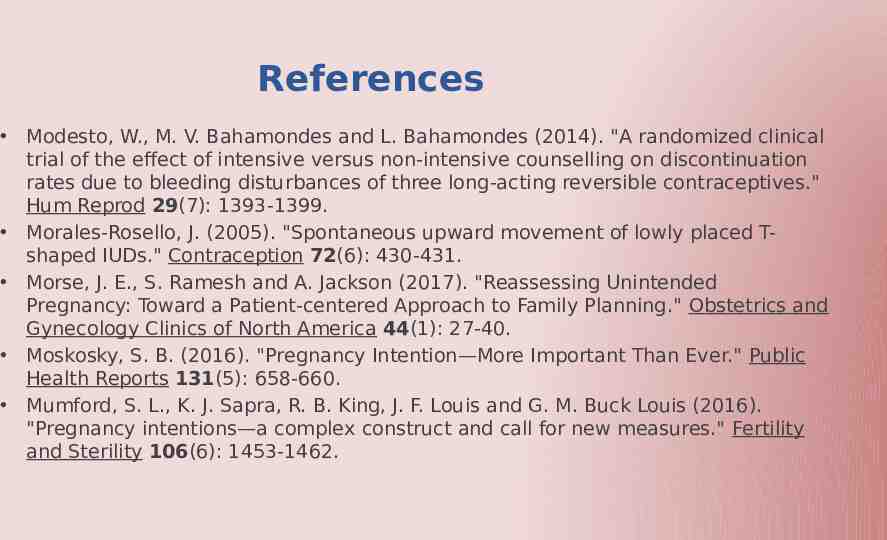
References Ussher, J. M. (2006). Managing the monstrous feminine : regulating the reproductive body. London ; New York, Routledge. Weisman, C. S. and C. H. Chuang (2014). "Making the most of the Affordable Care Act's contraceptive coverage mandate for privately-insured women." Womens Health Issues 24(5): 465-468. Woodsong, C., M. Shedlin and H. Koo (2004). "The 'natural' body, God and contraceptive use in the southeastern United States." Cult Health Sex 6(1): 61-78. Yazdany, J., L. Trupin, R. Kaiser, G. Schmajuk, J. Z. Gillis, E. Chakravarty and E. B. Schwarz (2011). "Contraceptive counseling and use among women with systemic lupus erythematosus: a gap in health care quality?" Arthritis Care Res (Hoboken) 63(3): 358-365. Yee, L. and M. Simon (2011). "Urban minority women's perceptions of and preferences for postpartum contraceptive counseling." J Midwifery Womens Health 56(1): 54-60.
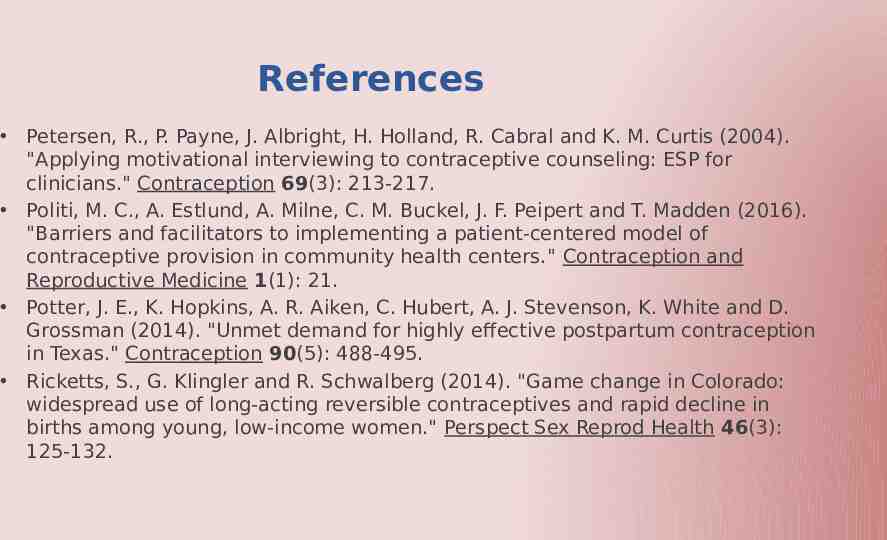
References Yee, L. M. and M. A. Simon (2011). "Perceptions of coercion, discrimination and other negative experiences in postpartum contraceptive counseling for lowincome minority women." J Health Care Poor Underserved 22(4): 1387-1400. Zapata, L. B., S. Murtaza, M. K. Whiteman, D. J. Jamieson, C. L. Robbins, P. A. Marchbanks, D. V. D'Angelo and K. M. Curtis (2015). "Contraceptive counseling and postpartum contraceptive use." Am J Obstet Gynecol 212(2): 171 e171178.
